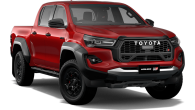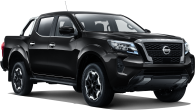Since 2016 the Toyota HiLux has been Australia's bestselling vehicle.
It's easy to see why. Accrued over half a century, the Japanese-branded but now Thai-built icon has gained a reputation worldwide for dauntless durability, making it the go-to one-tonne truck, as well as a true original.
But HiLux is under attack. From fresher rivals like the Ford Ranger and Isuzu D-Max. From highly-publicised diesel particulate filter (DPF) problems and the resulting engine breakdowns and lawsuits that have tarnished the series' image for reliability.
And, as you'll gather further on, from the ravages of time.
Now that a new Ranger has been launched and extensively driven, it's time to revisit Australia's favourite small truck/medium-sized ute/pick-up (the jury's still out on the nomenclature), in popular SR5 Double Cab 4x4 auto guise.
And for this particular test, the criteria is based on the urban environment so many HiLux owners evidently never venture beyond.
Toyota Hilux 2023: SR5 + Premium Interior (4X4)
| Engine Type | Diesel Turbo 4, 2.8L |
|---|---|
| Fuel Type | Diesel |
| Fuel Efficiency | 9.0L/100km (combined) |
| Seating | 5 |
| Price From | $58,740 - $67,540 |
| Safety Rating |
|
Does it represent good value for the price? What features does it come with?
On one hand, yes, since buying a HiLux buys into Toyota's renowned reputation for reliability and durability (DPF issues aside), as well as high resale value and a hungry second-hand market. It's long been the safe and sensible choice.
On the other, though, the current HiLux struggles to keep up with the class leaders on a range of fronts, more of which we will explore and expand on further down.
Kicking off from $60,680 (all prices are before on-road costs), the HiLux SR5 Double Cab (dual cab) auto is right in the thick of it, taking on the bestselling (and now auto-only) Ranger XLT (from $61,190), as well as the Mazda BT-50 GT (from $60,390), Isuzu D-Max LS-U (from $61,000), Nissan Navara ST-X (from $58,270) and Mitsubishi Triton GSR (from an alluring $55,590).
.jpg)
Yes, the Toyota is priced on the high side. But it could be better equipped for the money as well.
On the safety front all HiLuxes include seven airbags, autonomous emergency braking (AEB), lane departure alert/assist, speed-sign recognition, adaptive cruise control, trailer-sway control, hill-descent control and in-car SOS, auto collision notification and vehicle-tracking. More on those in the safety section below.
But where are the Toyota's blind-spot monitoring (BSM) and rear cross-traffic alert (RCTA)?
Among the SR5 goodies are keyless entry/push-button start, front/rear parking sensors, auto-levelling LED headlights, fog lights, dual-zone climate control, satellite navigation, DAB+ digital radio, a 220V accessory socket, a tow bar receiver, privacy glass, chromed exterior trim, heated exterior mirrors, a stainless-steel sports bar and 18-inch alloy wheels (with a full-sized spare).
.jpg)
These come on top of the cheaper SR's cooled centre box, side steps, six-speaker audio, and rear differential lock, as well as the base Workmate grade's auto on/off headlights, reverse camera, eight-inch touchscreen display, Apple CarPlay/Android Auto connectivity, Bluetooth telephony and audio streaming, voice-activated assistant, USB port, power windows and all-weather floor mats.
Our SR5 included the Premium pack, which costs $2500 extra, pushing the price up to a heady $63,180. It adds leather trim, heated front seats (powered on the driver's side) and height-adjustable front passenger seat with lumbar support.
However, this also means it's only about $500 short of the Ranger Sport from $63,690 and more than the Navara PRO-4X from $61,230, and both are more-highly specified vehicles.
.jpg)
To help address our value concerns, by the end of 2022, the SR5 will gain BSM, RCTA, a panoramic view monitor, an anti-theft immobiliser and door-mirror puddle lamps, though the latter look set to replace the existing heated exterior mirrors.
These and the other important upgrades can't come soon enough.
Is there anything interesting about its design?
Now well into its eighth generation, the existing HiLux was launched back in 2015, making it one of the oldest vehicles in its segment.
The 2020 facelift brought a number of visual, engineering, equipment and interior changes, some of which feature Australian input. These include a more aggressive-looking front end, upgrades to the suspension and steering, improved powertrain response, efficiency and cooling and higher payload capacity.
Still, a keen eye is required to tell apart new from old. Toyota uses words like "meaner" to describe the front end, but it remains very traditionally-HiLux 'friendly' in appearance and proportions.
Speaking of which, there's no escaping the SR5's tall and narrow look, especially compared to the latest Ranger, D-Max and GWM Ute. This has consequences for interior packaging and perception.

How practical is the space inside?
Bad news first.
After spending a considerable amount of time in the new Ranger, the HiLux's interior look, feel and presentation is very last decade, and the early part at that, with 2011 Camry, 2012 Corolla and 2014 RAV4 influences everywhere.
There's no escaping the narrow cabin feel, hard textures and sheeny surfaces everywhere, encompassing everything from the dated dashboard to the hollow-sounding door cards. We're talking cheap and old looking – though rattle free, hard-wearing and sturdy too. This is a truck, after all.
.jpg)
For some, finding the right driving position proves elusive. Even if of average height but long legged, the steering wheel's insufficient reach adjustment means having to bunch knees up a tad. Not comfortable over longer distances.
What's worse, over an extended period on them, the front seats lack any real support, seem too small in their frame for even medium-build drivers, and don't offer a driver's seat lumbar adjustment unless you pay extra for the Premium pack, which is a copout for the cash Toyota demands. And there is too much noise entering in, be it from the engine, suspension or road.
Along with being from another era, the SR5 lacks enough refinement and sophistication given its price point, falling well behind the class best.
.jpg)
Still, there's plenty to really like inside a HiLux, beginning with its overwhelming sense of familiarity and functional ease. That's the flipside of using 'proven' components, from the wheel and switchgear to the simple, effective climate control and 4x4 systems. It's all dead simple.
Though revised for 2020, the Toyota's instrument dials seem old-fashioned but clear (and with a handy auxiliary digital speedo to boot now), the auto gear lever is mercifully free of fly-by-wire nonsense that are laggy in engaging (hello, Ranger), and there's ample storage in the reasonably-sized glovebox, bonus lidded shelf above, big centre console and sturdy slide-out cupholders at each end of the dash to match the pair behind the gear lever as well as the huge bottle holders in the door.
And here's a nice touch. The gap between the driver's seat and console has a fold of fabric running the length of it, to catch keys, phones and other items from falling into an impenetrable void also known as underneath the seat. Minor but thoughtful.
.jpg)
Further plus points include plentiful ceiling lighting, a 220-volt household plug for appliances, a pair of 12V outlets and a USB-A outlet in the lower-dash area. Four entry-assist grab handles are fitted. The audio system quality is surprisingly good. And the touchscreen is handily sited within driver's easy reach and eye line, which is great for watching the reverse camera. Never mind the graphics, though, which look classic-era Nokia low-fi.
Moving to the rear, entry and egress is OK, and you sit much higher than the front occupants do, enabling great vision out. It isn't dingy or dark inside, despite the charcoal trim.
A folding armrest is well situated, with two cupholders, while the back doors can also accommodate a big bottle and additional storage. The windows wind all the way down, there are face-level centre air vents, two takeaway-food/bag carry hooks, overhead grab handles, handy rear-ceiling hooks mounted ahead of the back glass, and a pair of map pockets.
Plus, a cord under the seat lifts the cushion up to reveal two small under-floor storage areas (and a jack), though the press stud arrangement with the shockingly flimsy rear headrests is fiddly.
.jpg)
Sense a big but coming though? Here it is. Like most dual-cab pick-ups, the backrest angle is too upright, there isn't enough space for people with boots on to tuck feet beneath the front seat, and the knees-up seating position and low, unsupportive cushion spell discomfort and fatigue over longer journeys. And don't forget, it's noisy in there too.
The HiLux also feels a tad too narrow for three burly passengers to sit across the back without feeling stuffed in, and certainly seems smaller than the Ranger, D-Max, BT-50 and some other obviously larger rivals.
Finally, the tub area certainly betrays the Toyota's age. Lifting that tailgate up is a workout, there's no bed liner fitted as standard, and four crude aftermarket-looking handles are the only tie-downs you'll find. No load-area illumination, 12V outlets or cubby holes can be found. And cyclists won't be able to secure their bikes anywhere, as U-locks struggle to fit around the sports bar.
Payload is 995kg, braked towing capacity is 3500kg/750kg unbraked and the SR5's ground clearance is 216mm. More than adequate for most people then.
What are the key stats for the engine and transmission?
So is the SR5's stirring performance.
Leaving aside the DPF issues that are dogging Toyota's diesel engine (Prado and Fortuner are also affected), let's take a look at what's under the bonnet.
Part of the GD family of four-cylinder diesel engine family released with this generation HiLux in 2015, this is the 2755cc 2.8-litre twin-cam 16-valve 1GD-FTV four-cylinder common-rail turbo-diesel unit, producing 150kW of power between 3000-3400rpm, and 500Nm of torque from 1600-2800rpm.
Note, the six-speed manual alternative delivers 80Nm less torque than the six-speed torque-converter automatic transmission fitted to our test vehicle. The gear lever includes a sequential manual shift position, alongside the ECO and PWR mode buttons.
.jpg)
For the 2020 update, Toyota says it made changes to the combustion chamber, cylinder block, exhaust manifold and cooling system. A heavier-duty turbocharger and higher-pressure common-rail fuel-injection set-up were fitted to help provide a broader band of performance, and the auto was recalibrated for better economy and response. All involved Australian collaboration with overseas engineers.
Tipping the scales at 2110kg, the SR5 auto's power-to-weight ratio is 71.1kW/tonne. In contrast, the Ranger XLT 4x4 with the 154kW 2.0-litre Bi-Turbo at 2271kg and 184kW 3.0-litre V6 turbo-diesel at a hefty 2331kg come in at 67.8 and 78.9 kW/tonne respectively.
Brakes are a disc/drum front/rear arrangement, suspension is via a double wishbone/leaf-spring with rigid axle set-up and the steering is by hydraulic rack and pinion.
How much fuel does it consume?
Driven mostly around town and out on the open freeway at speed, we managed 10 litres per 100km bowser to bowser, against the trip computer's 9.4L/100km readout. This is about on a par with class standards.
The official combined average for the dual cab 4x4 auto is of 7.9L/100km. Urban/Extra Urban numbers are 9.4 and 7.0L/100km respectively, while the carbon dioxide emissions average is 207 grams/kilometre.
So, how far can you go on the 80-litre tank of diesel? Between 850km and 1140km, which averages out to around 1000km.
Warranty & Safety Rating
What safety equipment is fitted? What safety rating?
Tested in July 2019, the current HiLux has managed a five-star ANCAP crash-test rating.
On the safety front, all HiLuxes include seven airbags (dual front, side chest and curtain airbags that reach the rear-seat occupants' heads), AEB operational between 10km/h and 180km/h, with pedestrian and daytime cyclist detection operational between 10-80km/h, lane departure alert/assist operational between 50-180km/h, speed-sign recognition, adaptive cruise control, trailer-sway control, hill-descent control and in-car SOS, auto collision notification and vehicle-tracking.
However, until the 2023 update arrives, blind-spot monitoring and rear cross-traffic alert remain out of reach. It also misses out on rollover-mitigation control, tyre pressure monitors, a front-centre side airbag and rear disc brakes available on some rivals like Ranger, instead relying on drum brakes.
You'll also find front and rear parking sensors and seatbelt reminders for all seats, while the rear seats have two top tether anchors and two ISOFIX points.
What does it cost to own? What warranty is offered?
Toyota offers an industry-standard five-year/unlimited kilometre warranty. Plus, to encourage on-time Toyota dealer servicing patronage, the engine and driveline warranty is extended to seven years.
There is also seven years of roadside assistance, with Toyota covering car hire or towing expenses should the vehicle breakdown during this time.
However, service intervals for HiLux are every six months or 10,000km, which is an inconvenience given most rivals have 12-monthly intervals (or more). Additionally, the first service is due at 5000km.
Pricing is competitive, at $260 for the first 36 months or 60,000km – whichever occurs first. At 70,000km that rises to $321, jumping to $723 at 80,000km and then easing back to $501 at 90,000 and $413 for the 100,000km interval.
What's it like to drive around town?
Toyota says the 2020 HiLux received a raft of Aussie-influenced steering retuning and suspension upgrades, and – compared to the previous iteration – the changes seem to have worked.
Even at over five metres long, the SR5 dual cab is an easy vehicle to manoeuvre, thanks to light and agile steering, with little slack or vagueness. It's an easy car to place accurately, even if there is little to no feedback coming through the wheel.
Whether the suspension changes – including more-rigidly mounted and elongated leaf springs as well as uprated spring rates, shock absorbers and bushes – improve the urban ride enough is debatable.
The HiLux does a good job riding over larger humps, but smaller bumps are felt inside, making the ute seem busy and unsettled. A load in the back does calm things down, but unladen, you'd never call the SR5's suspension supple. It's behind the competition, especially you-know-who (with the badge that's blue).
.jpg)
That said, it's easy to understand why some many people are drawn to the HiLux on a very basic level.
Along with that familiar interior with all its easy controls, there's the driving experience. Or, more specifically, the Toyota's step-off acceleration. A non-car-enthusiast friend describes it as "instant attack", meaning the engine and gearing are tuned for instant throttle response. After the momentary turbo lag, this thing thrusts forward with fire in its belly. And that's in ECO mode!
The SR5's power just keeps on building well past legal freeway speeds, and is especially strong in the 60-100km/h overtaking range. If ever there was an apt application for the oft-used ‘punchy' performance cliché, then surely the muscular HiLux would be it.
Note, though, that there's so much instant torque on tap here, sometimes it overwhelms the grip, sending the traction control cut-outs into jolty overdrive. For this and other reasons, you never need use the manual shifter, let alone PWR mode.
These shouty letters tell another story, too. Away from the traffic-line grands prix glories, you're left with quite a noisy powertrain. Not gruff, just vocal. There's no confusion over what fuel this thing drinks.
.jpg)
Now, the HiLux's strident acceleration is fine on dry, smooth roads, but in the wet, or on bumpy surfaces, traction is too easily overcome, resulting in the 265/60R18 tyres losing their grip, impeding smooth and linear progress. In these scenarios you need to back off or suffer the scrappy power delivery.
The same applies through fast corners out on the open road, where the light and easy steering tells you precious little about how much the front wheels are gripping; combined with the jittery suspension, body lean and resulting tippy-toed feel, the Toyota seems nervous. Again, time to back off.
Whether in 2WD or 4WD High, the end result is the same. Except that the steering is a bit heavier and not as agile with both axles driven.
The bottom line is that the HiLux now feels too powerful for the chassis. At least the brakes do a great job hauling it up. No wonder Toyota is having another go for the coming 2023-model year update.
We'd wait for that one if it's an SR5 you have your heart set on.
Verdict
There will always be rusted-on Toyota fans who will buy a HiLux because of past reputations, future resale and the peace-of-mind that comes with familiarity, dependability and ease of operation today.
These accolades are largely earned from its traditional capabilities as a work vehicle or adventure machine, which you can read all about at CarsGuide's TradieGuide and AdventureGuide.
But for urban use, particularly with the new Ranger resetting class boundaries for comfort, smoothness, safety, performance, steering, handling and ride, it is increasingly difficult to overlook the SR5's high pricing, limited packaging, compromised driving position, dated interior and overall lack of refinement.
And, let's face it, those DPF issues have damaged the series' reliability reputation.
The HiLux now feels like a ute from another era. We don't hold out much hope of the coming upgrade fixing all of its issues, either. Roll on the next-generation version due in a few years.
Pricing Guides


.jpg)

.jpg)
.jpg)
.jpg)
.jpg)
.jpg)
.jpg)
.jpg)
.jpg)
.jpg)
.jpg)
.jpg)
.jpg)







.jpg)
.jpg)
.jpg)



.jpg)